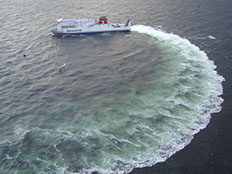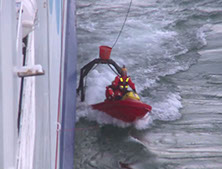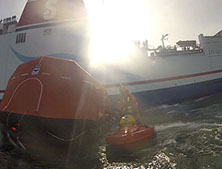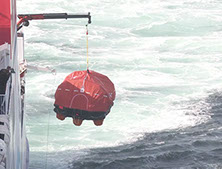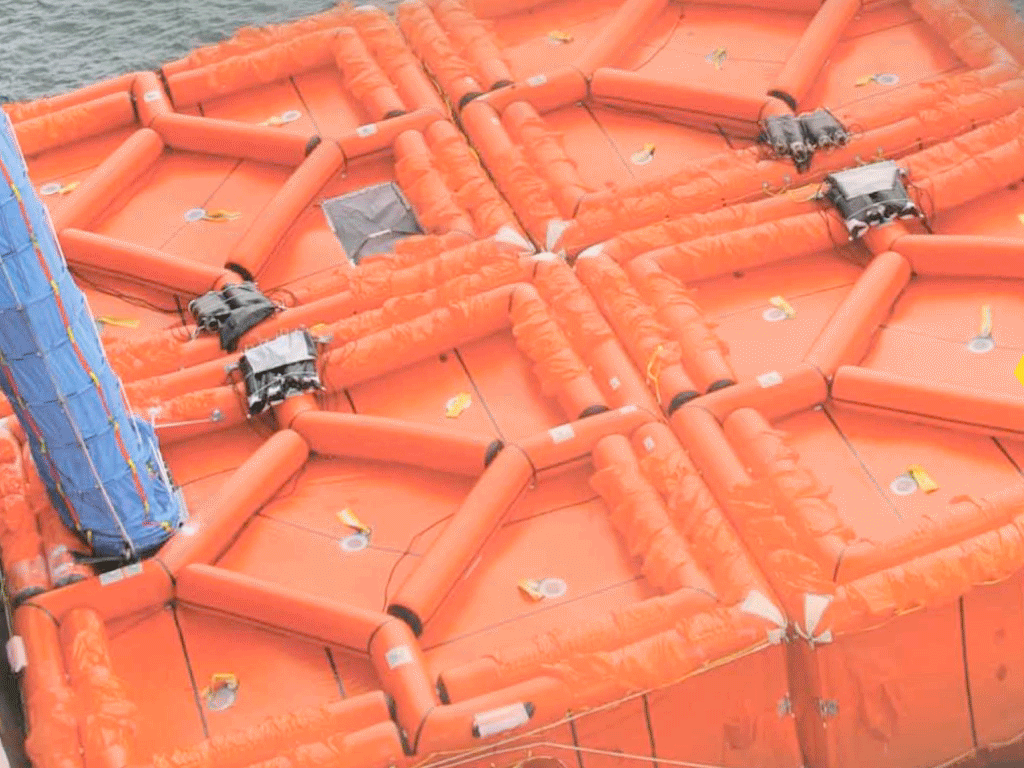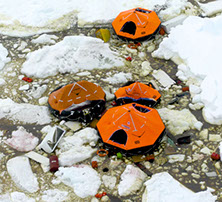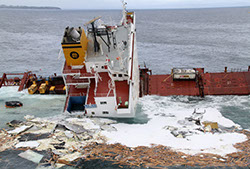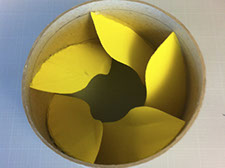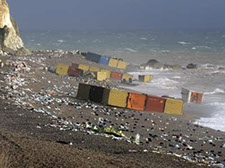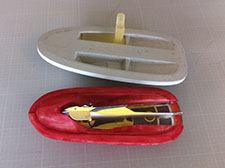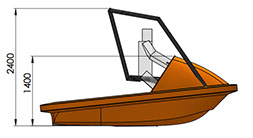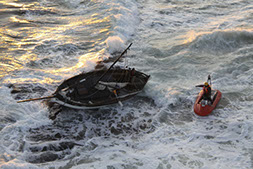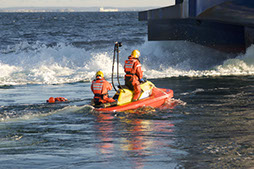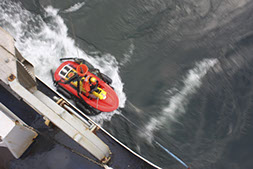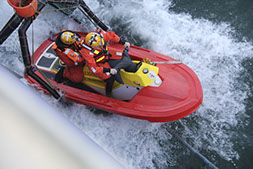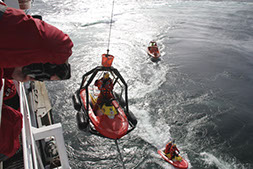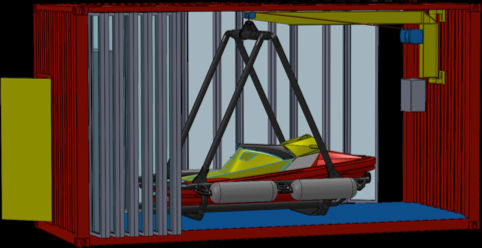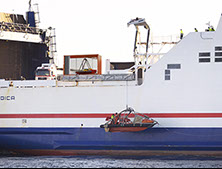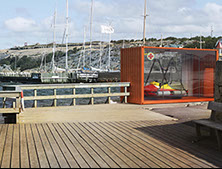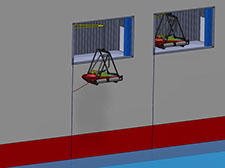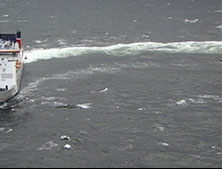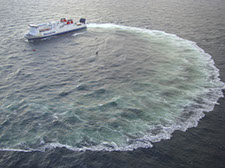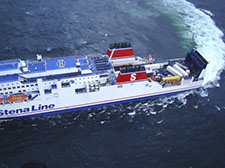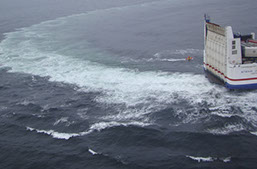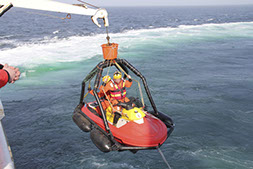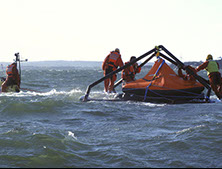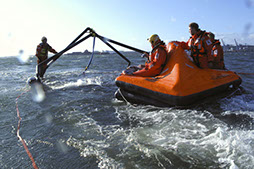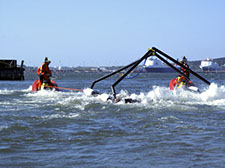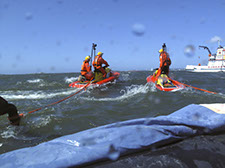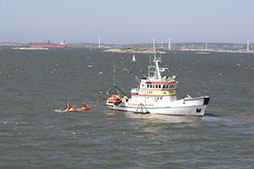The goal of the FIRST Project team is to make passenger ship catastrophes a thing of the past. We try to reach this goal by figuring out new ways to improve mass rescue, to test these ideas under realistic, harsh conditions, and by trying to convince the world that radical improvements are not only urgently needed, but also practically feasible and economically reasonable.
Here we share our progress on the overall goal and on some of the sub projects that we are pursuing.
3
Prototyping
5
Conclusion
7
1
2
4
6
Problem / Functionality
Implementation
Idea / Thesis
Testing
Public availability
The overall project
Filling the "SOLAS Gap"
Since the project start in 2007, we have developed and tested many facets of of our general idea of lifting life rafts to ships of opportunity. We can now confidently say that connecting and lifting rafts with people in them is efficient and realistic, even in harsh conditions.
Even though we encourage local implementation, we realize that international regulation is needed for this system to be a reality - for every passenger ship to have lift-able life rafts for evacuation, and for every suitable ship to have a means to connect and lift these rafts.
We also realize that major changes to international regulation is a tall order. But rest assured, we're working on it!
The first ship that comes to the scene circles the life rafts to calm the seas
The ship launches a Close Range Rescue Craft, CRRC, by means of a Drive Thru Cradle
The CRRC brings the crane wire to the raft while the ship maneuvers closer
The loaded raft is lifted to the safety on-board the ship. Up to 50 persons are rescued per lift.
Ongoing sub projects
Lift-able Marine Evacuation Systems (MES)
Problem - Many shipowners opt for Marine Evacuation Systems (MES) like the RFD Marine Ark. These systems offer performance for quick evacuation, but from a Mass Rescue perspective, they seem to be a dead end.
Idea - How might we divide the huge rafts of up to 150 persons capacity, that make up the MES, into smaller, lift-able units of 40-50 persons capacity?
Development - A thesis project at Chalmers University has looked into this problem. See more here!
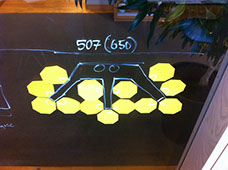
Rim Jet
Problem - Many ship accidents will produce a lot of floating debris as well as oil spills. Rescue boats, weather equipped with a water jet or a propeller, are vulnerable to debris, an can be made useless for hours by e.g. a rope that gets tangled and melts into a solid mass around the shaft.
Contaminated water can lead to loss engine cooling followed by engine failure.
Idea - A rim driven, shaft-less propulsor will have much less risk of getting stuck by debris. A fully electric solution would also mean less complexity and maintenance, as well as no cooling water system that could be compromised by other containments.
Development - We have put together a group of talented people from various industries, institutes and universities. Two thesis projects have been conducted at Rolls-Royce Propulsion. We hope to have a working prototype to begin testing during 2015.
Find out more about the project at surtsey.org!
(SOLAS) Close Range Rescue Craft, CRRC
Problem - Current SOLAS Rescue Boats and Fast Rescue Boats (FRB) are problematic in a number of situations; they are scary or dangerous to launch and recover in anything but moderate seas, they suffer from propulsion systems vulnerable to debris and oils, and they are to big, heavy and un-maneuverable to be safely and easily usable for connecting life rafts or picking up persons in water.
Proposition - For our tests, launching, recovering and connecting rafts with ROPAX ferry Stena Jutlandica, we have used a Rescuerunner instead of the ships' SOLAS boats. The Rescuerunner was developed by the SSRS for completely different uses, but has proven surprisingly good as a ship borne unit.
How might we adapt the benefits of the Rescuerunner and what we have learned from our tests to a (mostly) SOLAS compliant rescue boat?
Development - We are currently building a prototype for a slightly bigger boat than the Rescuerunner, optimized to be easy and safe to launch, recover and to use for going alongside rafts in rough weather.
We also hope to integrate the Rim Jet described among the other projects into this Close Range Rescue Craft.
Check out this for more on the Rescuerunner!
Drive Thru Cradle
Problem - Launching and recovering rescue boats from ships is scary and risky. Menacing hooks need to be connected and disconnected in the right order. Stress levels are high. Some systems are considered too dangerous to train with, at least in realistic weather.
In the rare cases of cradle-based systems, these are heavy contraptions, which leads to high impacts and more stress. They usually require the rescue boat to revers for launching, creating a situation of limited control.
Idea - With a smaller and lighter rescue boat, a light, semi-rigid cradle is possible. This means less impact and less risk for injury.
The drive thru design means that the boat is under full control during launching, and that there is less risk of falling back out during recovery.
Prototyping - We have gone through a number of prototypes and iterative adjustments to get to a simple, light and stable version that doesn't seam to have any unpleasant surprises for us.
Check out all versions beeing tested in the R&D Archive!
Testing - Launch and recovery in rough conditions, along side the Sea Calming Turn, has been one of the main parts of our test program with the Stena Jutlandica.
Go here for a video of the Stena Jutlandica Crew training with the Drive Thru Cradle
Conclusion - For a Rescuerunner-size water jet propelled boat, in conjunction with the Sea Calming Turn, we have yet to find conditions that would make launch and recovery dramatic, let alone impossible. Then again, we seldom get more than 4 m waves in our "sheltered" waters behind the Danish peninsula.
Availability - There is limited commercial availability with one major caveat: Only for Rescuerunners. Eventually we intend to adopt the cradle for the upcoming CRRC, and as long as it doesn't compromise it's safe characteristics, possibly also for bigger boats
Container Based Davit Station
Problem - Rescue boat davit stations are often stressful environments for both crew and equipment.
Placement sometimes seams like an afterthought.
Idea - By designing an enclosed davit station unit we hope to gain:
• A safe and minimally stressful environment for the rescue boat crew
• A way to visualize future installations in better, lower positions
• A protected environment for the equipment; easier maintenance
For our overall project:
• A complete unit that can be easily installed for testing on any ship
• An transportable unit that can also be demoed on land
Prototyping -
We are currently building a first working prototype.
Sea Calming Turn
Problem - Launching and recovering rescue boats from ships is scary and risky.
Working with rescue boats alongside rafts and persons in water is complicated by high seas.
The classic way of creating a lee by stopping a ship has limited effect and can have dangerous consequences for the helping ship
Idea - Many ships use the slack water inside a turn to make it easier for pilot boats to board. Could this principle be used to calm the seas by going around a full turn?
Would it even be helpful to have other ships circling well upwind?
Prototyping - This has all been in Captain Loréns head... But we hope to produce a masters checklist describing how best to perform the maneuver.
Testing - Partial to several full turns has been tested in varying weather up to 25 m/s winds and 3,5 m waves with the 185 m ROPAX ship Stena Jutlandica.
Some of the times we have used a wave buoy to measure the effect, but our usual evaluation method has been actually working, launching and recovering with small boats
We have also done limited simulations.
Conclusion - For the combined size and power o f the Jutlandica and the sea states that we have encountered, the method works remarkably well. The turn and some 28000 hp effectively flattens the seas, and the effect lasts for several minutes.
Tests in higher waves, with other ships, and with more controlled measuring are still needed.
Availability - Anyone can do it! Please do, and tell us what you learned!
Implementation - Eventually, we hope that the Sea Calming Turn will be part of the curriculum for Master Mariners.
Remote Life Raft Connection
Problem - Even though we think we have a reasonable solution to how to connect life rafts (with an CRRC), sometimes it might be best to not have to send crew members onto the water.
Idea - How might we use an Unmanned Aerial Vehicle (UAV) and an automatic hook, or som other creative solution, to connect life rafts remotely?
Check out this Call-for-projects for remotely connecting life rafts!
An inspiring example - the sturdy coanda effect UAV
Canceled/finished sub projects
Life Raft Recovery Cradle
Problem - Most life rafts are not designed to be lifted. Can we create equipment that would make it possible to lift any kind of raft to any suitable ship?
Idea - Two rescue boats might tow a light "raft catcher" that could then provide strength and stability to lift the raft with people in it.
Prototyping - Two working prototypes were developed, the first one big enough for up yo 12 person rafts, the second for rafts up to 25 persons. After the success of the Drive Thru Cradle, the same welded polyethylene construction was used.
Testing - The prototypes were tested under varying conditions, and were deemed to be working, but somewhat cumbersome solutions to the problem.
Conclusion - No go! The LRRC-project was stopped for a number of reasons:
• It complicates our message - we think all life rafts should be lift-able
• Complicated, slow and personnel-intensive
• Questionable how well it would scale to bigger rafts
© 2013 SJÖRÄDDNINGSSÄLLSKAPET · PLUSGIRO: 900 500-0 · BANKGIRO: 900-5000




